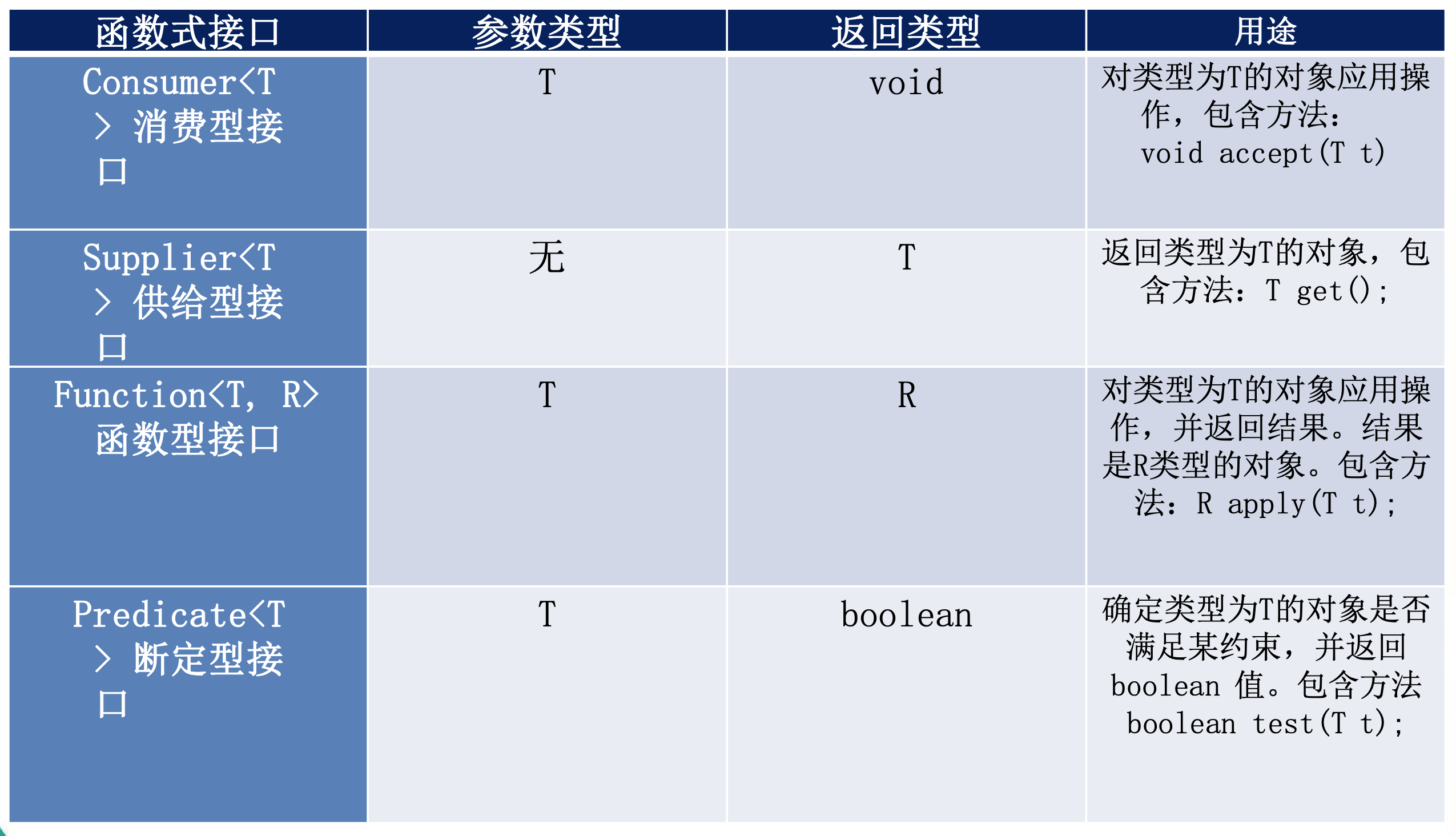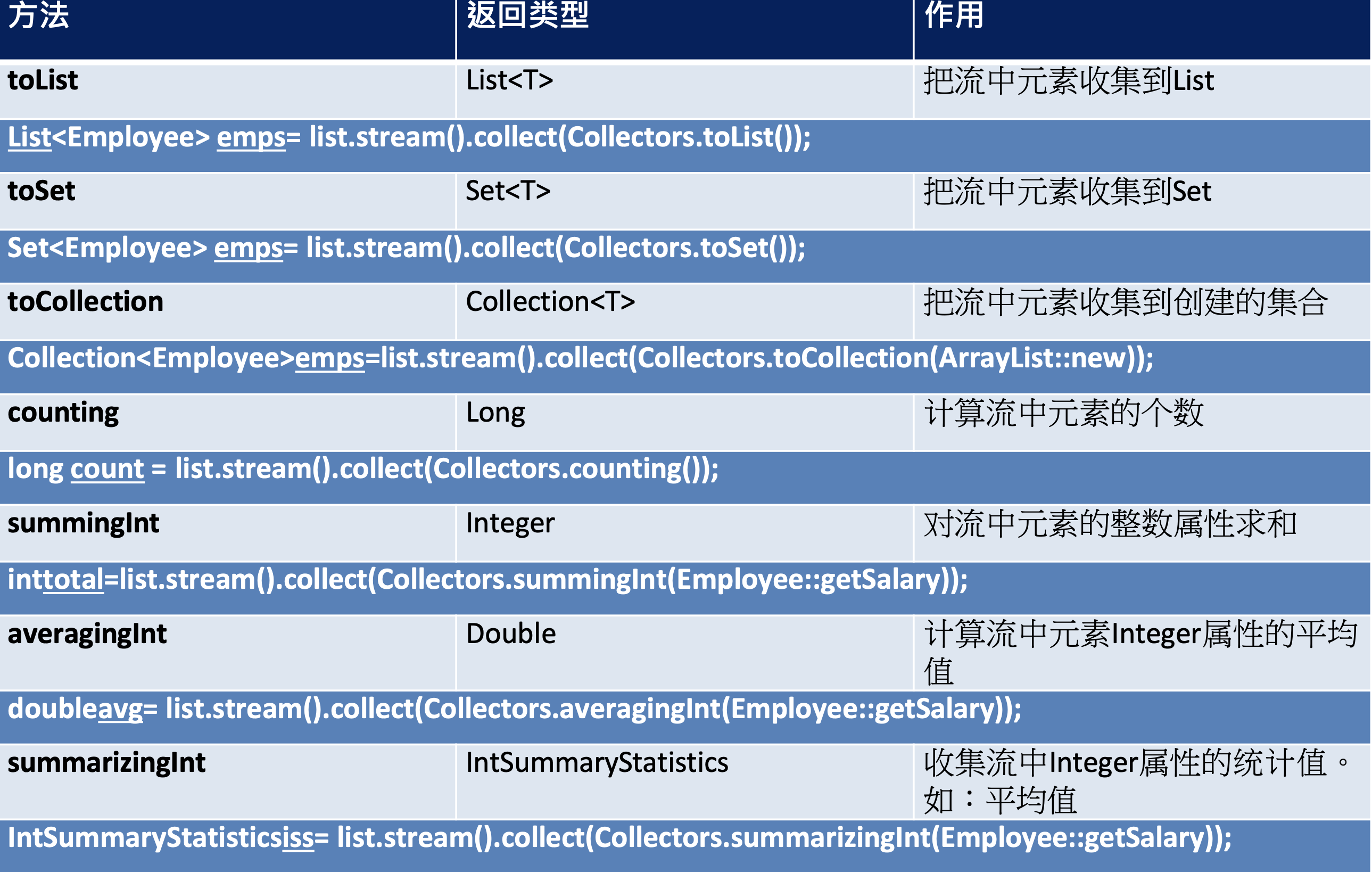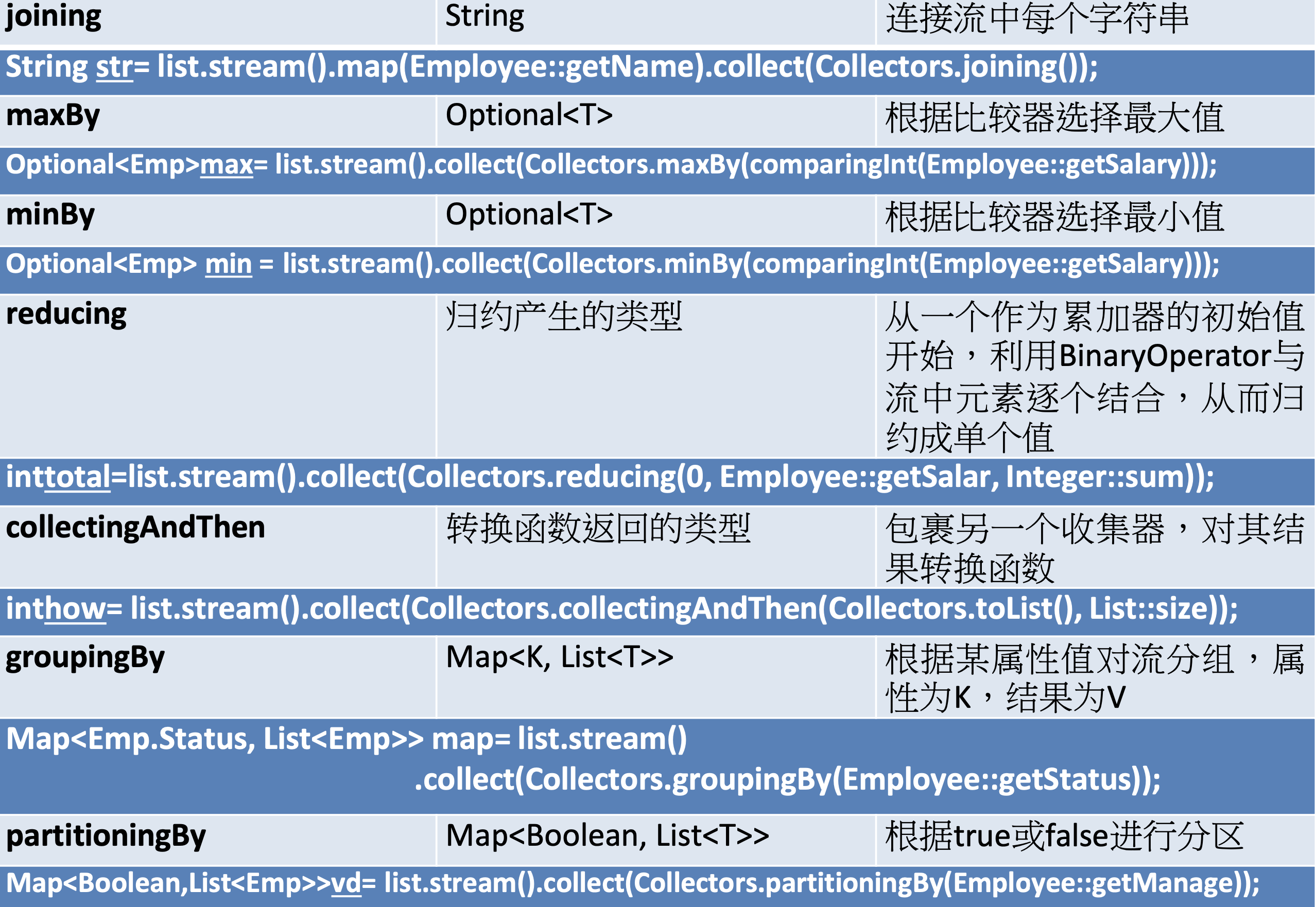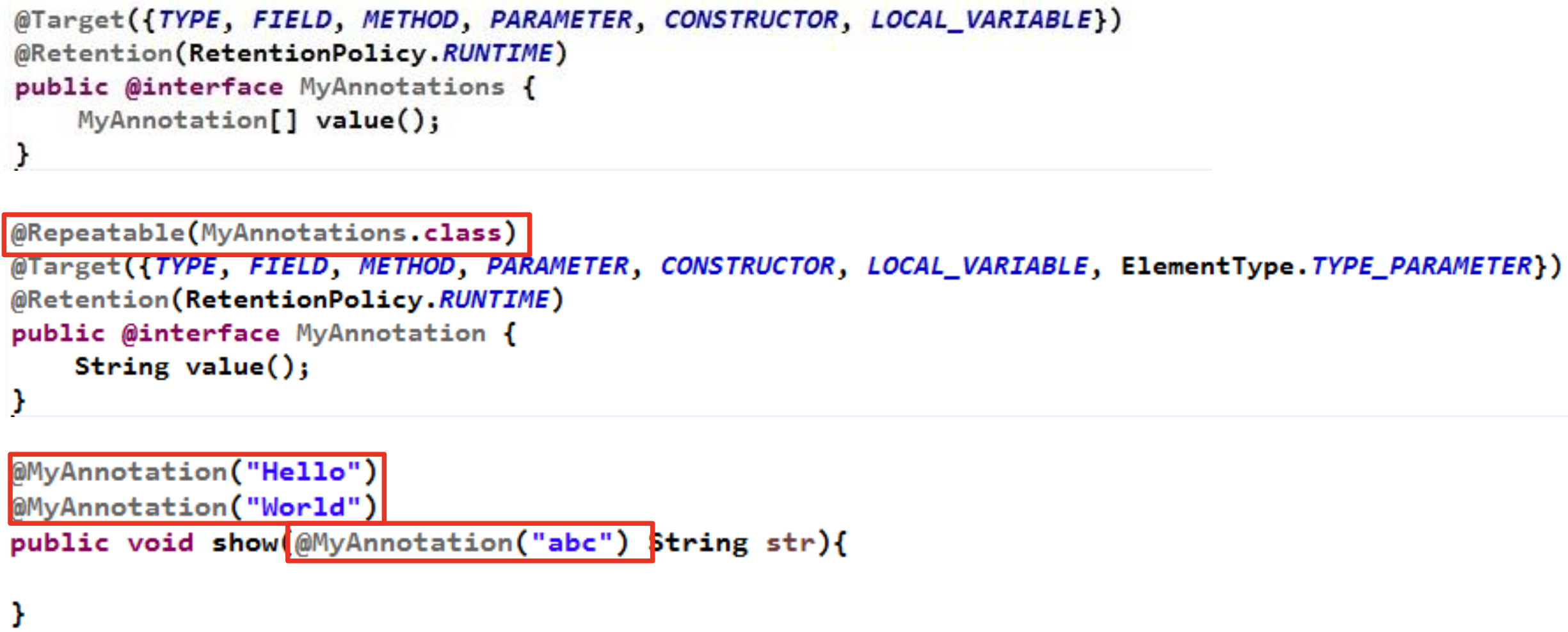一、集合
1、HashMap
- 数组+链表+红黑树
2、HashSet
- 数组+链表+红黑树
3、ConcurrentHashMap
- CAS + Synchronized
二、JVM
方法区:永久代PremGen --> 元空间MetaSpace(物理内存)
三、Lambda 表达式
1、从匿名类到Lambda的转换
匿名内部类
//原来的匿名内部类
@Test
public void test1(){
Comparator<String> com = new Comparator<String>(){
@Override
public int compare(String o1, String o2) {
return Integer.compare(o1.length(), o2.length());
}
};
TreeSet<String> ts = new TreeSet<>(com);
TreeSet<String> ts2 = new TreeSet<>(new Comparator<String>(){
@Override
public int compare(String o1, String o2) {
return Integer.compare(o1.length(), o2.length());
}
});
}
//现在的 Lambda 表达式
@Test
public void test2(){
Comparator<String> com = (x, y) -> Integer.compare(x.length(), y.length());
TreeSet<String> ts = new TreeSet<>(com);
}
2、Lambda 表达式的基础语法
Java8中引入了一个新的操作符 “->” 该操作符称为箭头操作符或 Lambda 操作符
箭头操作符将 Lambda 表达式拆分成两部分:
左侧:Lambda 表达式的参数列表
右侧:Lambda 表达式中所需执行的功能, 即 Lambda 体
语法格式一:无参数,无返回值
() -> System.out.println("Hello Lambda!");
语法格式二:有一个参数,并且无返回值
(x) -> System.out.println(x)
语法格式三:若只有一个参数,小括号可以省略不写
x -> System.out.println(x)
语法格式四:有两个以上的参数,有返回值,并且 Lambda 体中有多条语句
Comparator<Integer> com = (x, y) -> {
System.out.println("函数式接口");
return Integer.compare(x, y);
}
语法格式五:若 Lambda 体中只有一条语句, return 和 大括号都可以省略不写
Comparator<Integer> com = (x, y) -> Integer.compare(x, y);
语法格式六:Lambda 表达式的参数列表的数据类型可以省略不写,因为JVM编译器通过上下文推断出,数据类型,即“类型推断”
(Integer x, Integer y) -> Integer.compare(x, y);
上联:左右遇一括号省
下联:左侧推断类型省
横批:能省则省
3、Lambda 表达式需要“函数式接口”的支持
函数式接口:接口中只有一个抽象方法的接口,称为函数式接口。
可以使用注解 @FunctionalInterface 修饰,可以检查是否是函数式接口
四、函数式接口
1、什么是函数式接口?
- 只包含一个抽象方法的接口
- 可以通过Lambda表达式来创建该接口的对象。(若 Lambda表达式抛出一个受检异常,那么该异常需要在目标接口的抽象方法_上进行声明)
- 可以在任意函数式接口上使用@FunctionalInterface注解,这样做可以检查它是否是一个函数式接口,同时javadoc 也会包含一条声明,说明这个接口是一个函数式接口。
2、自定义函数式接口
@FunctionalInterface
public interface MyNumber {
public double getValue();
}
函数式接口中使用泛型:
@FunctionalInterface
public interface MyFunc<T> {
public T getValue(T t);
}
作为参数传递Lambda表达式:
public String toUpperString (MyFunc<String> mf,String str) {
return mf .getValue(str);
}
String newStr = toUpperString(
(str) -> str.toUpperCase(),"abcdef");
System.out.println(newStr);
为了将Lambda 表达式作为参数传递,接收Lambda表达式的参数类型必须是与该Lambda表达式兼容的函数式接口的类型。
3、Java8 内置的四大核心函数式接口

- Consumer : 消费型接口
- void accept(T t);
- Supplier : 供给型接口
- T get();
- Function<T, R> : 函数型接口
- R apply(T t);
- Predicate : 断言型接口
- boolean test(T t);
Consumer 消费型接口
@Test
public void test1(){
happy(10000, (m) -> System.out.println("去超市消费:" + m + "元"));
}
public void happy(double money, Consumer<Double> con){
con.accept(money);
}
Supplier 供给型接口
@Test
public void test2(){
List<Integer> numList = getNumList(10, () -> (int)(Math.random() * 100));
for (Integer num : numList) {
System.out.println(num);
}
}
//需求:产生指定个数的整数,并放入集合中
public List<Integer> getNumList(int num, Supplier<Integer> sup){
List<Integer> list = new ArrayList<>();
for (int i = 0; i < num; i++) {
Integer n = sup.get();
list.add(n);
}
return list;
}
Function<T, R> 函数型接口
@Test
public void test3(){
String newStr = strHandler("\t\t\t 我大尚硅谷威武 ", (str) -> str.trim());
System.out.println(newStr);
String subStr = strHandler("我大尚硅谷威武", (str) -> str.substring(2, 5));
System.out.println(subStr);
}
//需求:用于处理字符串
public String strHandler(String str, Function<String, String> fun){
return fun.apply(str);
}
Predicate 断言型接口
@Test
public void test4(){
List<String> list = Arrays.asList("Hello", "atguigu", "Lambda", "www", "ok");
List<String> strList = filterStr(list, (s) -> s.length() > 3);
for (String str : strList) {
System.out.println(str);
}
}
//需求:将满足条件的字符串,放入集合中
public List<String> filterStr(List<String> list, Predicate<String> pre){
List<String> strList = new ArrayList<>();
for (String str : list) {
if(pre.test(str)){
strList.add(str);
}
}
return strList;
}
五、方法引用与构造器引用
1、方法引用
当要传递给Lambda体的操作,已经有实现的方法了,可以使用方法引用!
(实现抽象方法的参数列表,必须与方法引用方法的参数列表保持一致! )
方法引用:使用操作符“::”将方法名和对象或类的名字分隔开来。
如下三种主要使用情况:
- 对象::实例方法
- 类::静态方法
- 类::实例方法
1.1 对象的引用 :: 实例方法名
@Test
public void test1(){
PrintStream ps = System.out;
Consumer<String> con = (str) -> ps.println(str);
con.accept("Hello World!");
System.out.println("--------------------------------");
Consumer<String> con2 = ps::println;
con2.accept("Hello Java8!");
Consumer<String> con3 = System.out::println;
}
@Test
public void test2(){
Employee emp = new Employee(101, "张三", 18, 9999.99);
Supplier<String> sup = () -> emp.getName();
System.out.println(sup.get());
System.out.println("----------------------------------");
Supplier<String> sup2 = emp::getName;
System.out.println(sup2.get());
}
1.2 类名 :: 静态方法名
@Test
public void test3(){
BiFunction<Double, Double, Double> fun = (x, y) -> Math.max(x, y);
System.out.println(fun.apply(1.5, 22.2));
System.out.println("----------------------------------");
BiFunction<Double, Double, Double> fun2 = Math::max;
System.out.println(fun2.apply(1.2, 1.5));
}
@Test
public void test4(){
Comparator<Integer> com = (x, y) -> Integer.compare(x, y);
System.out.println("-------------------------------------");
Comparator<Integer> com2 = Integer::compare;
}
1.3 类名 :: 实例方法名
注意:当需要引用方法的第-一个参数是调用对象,并且第二个参数是需要引
用方法的第二个参数(或无参数)时: ClassName: :methodName .
@Test
public void test5(){
BiPredicate<String, String> bp = (x, y) -> x.equals(y);
System.out.println(bp.test("abcde", "abcde"));
System.out.println("---------------------------------------");
BiPredicate<String, String> bp2 = String::equals;
System.out.println(bp2.test("abc", "abc"));
System.out.println("---------------------------------------");
Function<Employee, String> fun = (e) -> e.show();
System.out.println(fun.apply(new Employee()));
System.out.println("---------------------------------------");
Function<Employee, String> fun2 = Employee::show;
System.out.println(fun2.apply(new Employee()));
}
2、构造器引用
格式: ClassName::new
与函数式接口相结合,自动与函数式接口中方法兼容。可以把构造器引用赋值给定义的方法,与构造器参数列表要与接口中抽象方法的参数列表一致!
示例:
@Test
public void test6(){
Supplier<Employee> sup = () -> new Employee();
System.out.println(sup.get());
System.out.println("------------------------------------");
Supplier<Employee> sup2 = Employee::new;
System.out.println(sup2.get());
}
@Test
public void test7(){
Function<String, Employee> fun = Employee::new;
BiFunction<String, Integer, Employee> fun2 = Employee::new;
}
3、数组引用
格式: type[]::new
示例:
@Test
public void test8(){
Function<Integer, String[]> fun = (args) -> new String[args];
String[] strs = fun.apply(10);
System.out.println(strs.length);
System.out.println("--------------------------");
Function<Integer, Employee[]> fun2 = Employee[] :: new;
Employee[] emps = fun2.apply(20);
System.out.println(emps.length);
}
六、Stream
1、什么是Stream?
Java8中有两大最为重要的改变。第一个是Lambda表达式;另外一个则是Stream API(java. util. stream. *)。
Stream是Java8中处理集合的关键抽象概念,它可以指定你希望对集合进行的操作,可以执行非常复杂的查找、过滤和映射数据等操作。使用Stream API对集合数据进行操作,就类似于使用SQL 执行的数据库查询。也可以使用Stream API来并行执行操作。简而言之,Stream API提供了一-种高效且易于使用的处理数据的方式。
流(Stream)到底是什么呢?
是数据渠道,用于操作数据源(集合、数组等)所生成的元素序列。
“集合讲的是数据,流讲的是计算!
”
注意:
①Stream自己不会存储元素。
②Stream不会改变源对象。相反,他们会返回一个持有结果的新Stream。
③Stream操作是延迟执行的。这意味着他们会等到需要结果的时候才执行。
2、Stream的操作三个步骤
- 创建Stream
- 一个数据源(如:集合、数组) ,获取一个流
- 中间操作
- 一个中间操作链,对数据源的数据进行处理
- 终止操作(终端操作)
- 一个终止操作,执行中间操作链,并产生结果

2.1 创建Stream
Java8中的Collection接口被扩展,提供了两个获取流的方法:
- default Stream stream() :返回一个顺序流
- default Stream parallelStream() :返回一个并行流
由数组创建流
Java8 中的Arrays的静态方法stream()可以获取数组流:
static Stream stream(T[] array):返回一个流
重载形式,能够处理对应基本类型的数组:
- public static IntStream stream(int[] array)
- public static LongStream stream(long[] array)
- public static DoubleStream stream (double[] array)
由值创建流
可以使用静态方法Stream.of(), 通过显示值创建一个流。它可以接收任意数量的参数。
public static Stream of(T… values) :返回一个流
由函数创建流:创建无限流
可以使用静态方法Stream. iterate()和Stream. generate() ,创建无限流。
- 迭代
- public static Stream iterate(final T seed, final UnaryOperator f)
- 生成
- public static Stream generate (Supplier s) :
示例:
@Test
public void test1(){
//1. Collection 提供了两个方法 stream() 与 parallelStream()
List<String> list = new ArrayList<>();
Stream<String> stream = list.stream(); //获取一个顺序流
Stream<String> parallelStream = list.parallelStream(); //获取一个并行流
//2. 通过 Arrays 中的 stream() 获取一个数组流
Integer[] nums = new Integer[10];
Stream<Integer> stream1 = Arrays.stream(nums);
//3. 通过 Stream 类中静态方法 of()
Stream<Integer> stream2 = Stream.of(1,2,3,4,5,6);
//4. 创建无限流
//迭代
Stream<Integer> stream3 = Stream.iterate(0, (x) -> x + 2).limit(10);
stream3.forEach(System.out::println);
//生成
Stream<Double> stream4 = Stream.generate(Math::random).limit(2);
stream4.forEach(System.out::println);
}
2.2 Stream的中间操作
多个中间操作可以连接起来形成一个流水线,除非流水线上触发终止操作,否则中间操作不会执行任何的处理!而在终止操作时一次性全部处理,称为“惰性求值”
筛选与切片

示例:
//内部迭代:迭代操作 Stream API 内部完成
@Test
public void test2(){
//所有的中间操作不会做任何的处理
Stream<Employee> stream = emps.stream()
.filter((e) -> {
System.out.println("测试中间操作");
return e.getAge() <= 35;
});
//只有当做终止操作时,所有的中间操作会一次性的全部执行,称为“惰性求值”
stream.forEach(System.out::println);
}
//外部迭代
@Test
public void test3(){
Iterator<Employee> it = emps.iterator();
while(it.hasNext()){
System.out.println(it.next());
}
}
@Test
public void test4(){
emps.stream()
.filter((e) -> {
System.out.println("短路!"); // && ||
return e.getSalary() >= 5000;
}).limit(3)
.forEach(System.out::println);
}
@Test
public void test5(){
emps.parallelStream()
.filter((e) -> e.getSalary() >= 5000)
.skip(2)
.forEach(System.out::println);
}
@Test
public void test6(){
emps.stream()
.distinct()
.forEach(System.out::println);
}
映射

示例:
@Test
public void test1(){
Stream<String> str = emps.stream()
.map((e) -> e.getName());
System.out.println("---------------------------------------");
List<String> strList = Arrays.asList("aaa", "bbb", "ccc", "ddd", "eee");
Stream<String> stream = strList.stream()
.map(String::toUpperCase);
stream.forEach(System.out::println);
Stream<Stream<Character>> stream2 = strList.stream()
.map(TestStreamAPI1::filterCharacter);
stream2.forEach((sm) -> {
sm.forEach(System.out::println);
});
System.out.println("---------------------------------------");
Stream<Character> stream3 = strList.stream()
.flatMap(TestStreamAPI1::filterCharacter);
stream3.forEach(System.out::println);
}
public static Stream<Character> filterCharacter(String str){
List<Character> list = new ArrayList<>();
for (Character ch : str.toCharArray()) {
list.add(ch);
}
return list.stream();
}
排序

示例:
@Test
public void test2(){
emps.stream()
.map(Employee::getName)
.sorted()
.forEach(System.out::println);
System.out.println("------------------------------------");
emps.stream()
.sorted((x, y) -> {
if(x.getAge() == y.getAge()){
return x.getName().compareTo(y.getName());
}else{
return Integer.compare(x.getAge(), y.getAge());
}
}).forEach(System.out::println);
}
2.3 Stream的终止操作
终端操作会从流的流水线生成结果。其结果可以是任何不是流的值,例如: List、 Integer, 甚至是void 。
查找与匹配

示例:
@Test
public void test1(){
boolean bl = emps.stream()
.allMatch((e) -> e.getStatus().equals(Status.BUSY));
System.out.println(bl);
boolean bl1 = emps.stream()
.anyMatch((e) -> e.getStatus().equals(Status.BUSY));
System.out.println(bl1);
boolean bl2 = emps.stream()
.noneMatch((e) -> e.getStatus().equals(Status.BUSY));
System.out.println(bl2);
}
@Test
public void test2(){
Optional<Employee> op = emps.stream()
.sorted((e1, e2) -> Double.compare(e1.getSalary(), e2.getSalary()))
.findFirst();
System.out.println(op.get());
System.out.println("--------------------------------");
Optional<Employee> op2 = emps.parallelStream()
.filter((e) -> e.getStatus().equals(Status.FREE))
.findAny();
System.out.println(op2.get());
}
计算

示例:
@Test
public void test3(){
long count = emps.stream()
.filter((e) -> e.getStatus().equals(Status.FREE))
.count();
System.out.println(count);
Optional<Double> op = emps.stream()
.map(Employee::getSalary)
.max(Double::compare);
System.out.println(op.get());
Optional<Employee> op2 = emps.stream()
.min((e1, e2) -> Double.compare(e1.getSalary(), e2.getSalary()));
System.out.println(op2.get());
}
//注意:流进行了终止操作后,不能再次使用
@Test
public void test4(){
Stream<Employee> stream = emps.stream()
.filter((e) -> e.getStatus().equals(Status.FREE));
long count = stream.count();
stream.map(Employee::getSalary)
.max(Double::compare);
}
规约

示例:
@Test
public void test1(){
List<Integer> list = Arrays.asList(1,2,3,4,5,6,7,8,9,10);
Integer sum = list.stream()
.reduce(0, (x, y) -> x + y);
System.out.println(sum);
System.out.println("---------------------------------------");
Optional<Double> op = emps.stream()
.map(Employee::getSalary)
.reduce(Double::sum);
System.out.println(op.get());
}
//需求:搜索名字中 “六” 出现的次数
@Test
public void test2(){
Optional<Integer> sum = emps.stream()
.map(Employee::getName)
.flatMap(TestStreamAPI1::filterCharacter)
.map((ch) -> {
if(ch.equals('六'))
return 1;
else
return 0;
}).reduce(Integer::sum);
System.out.println(sum.get());
}
收集

Collector接口中方法的实现决定了如何对流执行收集操作(如收集到List、Set、Map)。但是Collectors 实用类提供了很多静态方法,可以方便地创建常见收集器实例,具体方法与实例如下表:


示例:
@Test
public void test3(){
List<String> list = emps.stream()
.map(Employee::getName)
.collect(Collectors.toList());
list.forEach(System.out::println);
System.out.println("----------------------------------");
Set<String> set = emps.stream()
.map(Employee::getName)
.collect(Collectors.toSet());
set.forEach(System.out::println);
System.out.println("----------------------------------");
HashSet<String> hs = emps.stream()
.map(Employee::getName)
.collect(Collectors.toCollection(HashSet::new));
hs.forEach(System.out::println);
}
@Test
public void test4(){
Optional<Double> max = emps.stream()
.map(Employee::getSalary)
.collect(Collectors.maxBy(Double::compare));
System.out.println(max.get());
Optional<Employee> op = emps.stream()
.collect(Collectors.minBy((e1, e2) -> Double.compare(e1.getSalary(), e2.getSalary())));
System.out.println(op.get());
Double sum = emps.stream()
.collect(Collectors.summingDouble(Employee::getSalary));
System.out.println(sum);
Double avg = emps.stream()
.collect(Collectors.averagingDouble(Employee::getSalary));
System.out.println(avg);
Long count = emps.stream()
.collect(Collectors.counting());
System.out.println(count);
System.out.println("--------------------------------------------");
DoubleSummaryStatistics dss = emps.stream()
.collect(Collectors.summarizingDouble(Employee::getSalary));
System.out.println(dss.getMax());
}
//分组
@Test
public void test5(){
Map<Status, List<Employee>> map = emps.stream()
.collect(Collectors.groupingBy(Employee::getStatus));
System.out.println(map);
}
//多级分组
@Test
public void test6(){
Map<Status, Map<String, List<Employee>>> map = emps.stream()
.collect(Collectors.groupingBy(Employee::getStatus, Collectors.groupingBy((e) -> {
if(e.getAge() >= 60)
return "老年";
else if(e.getAge() >= 35)
return "中年";
else
return "成年";
})));
System.out.println(map);
}
//分区
@Test
public void test7(){
Map<Boolean, List<Employee>> map = emps.stream()
.collect(Collectors.partitioningBy((e) -> e.getSalary() >= 5000));
System.out.println(map);
}
//
@Test
public void test8(){
String str = emps.stream()
.map(Employee::getName)
.collect(Collectors.joining("," , "----", "----"));
System.out.println(str);
}
@Test
public void test9(){
Optional<Double> sum = emps.stream()
.map(Employee::getSalary)
.collect(Collectors.reducing(Double::sum));
System.out.println(sum.get());
}
3、并行流与串行流
并行流就是把一个内容分成多个数据块,并用不同的线程分别处理每个数据块的流。
Java 8中将并行进行了优化,我们可以很容易的对数据进行并行操作。Stream API可以声明性地通过parallel() 与sequential()在并行流与顺序流之间进行切换。
3.1 Fork/Join框架
Fork/Join 框架:就是在必要的情况下,将-一个大任务,进行拆分(fork)成若干个小任务(拆到不可再拆时),再将一个个的小任务运算的结果进行join汇总.

3.2 Fork/ Join框架与传统线程池的区别
采用“工作窃取”模式(work-stealing) :
当执行新的任务时它可以将其拆分分成更小的任务执行,并将小任务加到线程队列中,然后再从一个随机线程的队列中偷一个并把它放在自己的队列中。
相对于一般的线程池实现,fork/join框架的优势体现在对其中包含的任务的处理方式上.在一般的线程池中,如果一个线程正在执行的任务由于某些原因无法继续运行,那么该线程会处于等待状态.而在fork/ join框架实现中,如果某个子问题由于等待另外一个子问题的完成而无法继续运行.那么处理该子问题的线程会主动寻找其他尚未运行的子问题来执行.这种方式减少了线程的等待时间,提高了性能.
3.3 对比与测试
import java.util.concurrent.RecursiveTask;
public class ForkJoinCalculate extends RecursiveTask<Long>{
/**
*
*/
private static final long serialVersionUID = 13475679780L;
private long start;
private long end;
private static final long THRESHOLD = 10000L; //临界值
public ForkJoinCalculate(long start, long end) {
this.start = start;
this.end = end;
}
@Override
protected Long compute() {
long length = end - start;
if(length <= THRESHOLD){
long sum = 0;
for (long i = start; i <= end; i++) {
sum += i;
}
return sum;
}else{
long middle = (start + end) / 2;
ForkJoinCalculate left = new ForkJoinCalculate(start, middle);
left.fork(); //拆分,并将该子任务压入线程队列
ForkJoinCalculate right = new ForkJoinCalculate(middle+1, end);
right.fork();
return left.join() + right.join();
}
}
}
import java.util.concurrent.ForkJoinPool;
import java.util.concurrent.ForkJoinTask;
import java.util.stream.LongStream;
import org.junit.Test;
public class TestForkJoin {
// 方式1:传统的for循环遍历
@Test
public void test1(){
long start = System.currentTimeMillis();
long sum = 0L;
for (long i = 0L; i <= 10000000000L; i++) {
sum += i;
}
System.out.println(sum);
long end = System.currentTimeMillis();
System.out.println("耗费的时间为: " + (end - start)); //5233ms
}
// 方式2:使用fork-join框架
@Test
public void test2(){
long start = System.currentTimeMillis();
ForkJoinPool pool = new ForkJoinPool();
ForkJoinTask<Long> task = new ForkJoinCalculate(0L, 10000000000L);
long sum = pool.invoke(task);
System.out.println(sum);
long end = System.currentTimeMillis();
System.out.println("耗费的时间为: " + (end - start)); //1780ms
}
// 方式3:使用stream并行流
@Test
public void test3(){
long start = System.currentTimeMillis();
Long sum = LongStream.rangeClosed(0L, 10000000000L)
.parallel()
.sum();
System.out.println(sum);
long end = System.currentTimeMillis();
System.out.println("耗费的时间为: " + (end - start)); //1248ms
}
}
七、Optional类
Optional类(java. util. Optional)是一个容器类,代表一个值存在或不存在,
原来用null表示一个值不存在,现在Optional 可以更好的表达这个概念。并且
可以避免空指针异常。
1、常用方法
- Optional.of(T t) :创建一个Optional 实例
- Optional.empty() :创建一个空的Optional 实例
- Optional.ofNullable(T t):若t不为null, 创建Optional实例,否则创建空实例
- isPresent() :判断是否包含值
- orElse(T t):如果调用对象包含值,返回该值,否则返回t
- orElseGet (Supplier s) : 如果调用对象包含值,返回该值,否则返回s获取的值
- map (Function f):如果有值对其处理,并返回处理后的Optional,否则返回Optional. empty ()
- flatMap (Function mapper) :与map类似,要求返回值必须是0ptional
2、使用示例
@Test
public void test1(){
Optional<Employee> op = Optional.of(new Employee());
Employee emp = op.get();
System.out.println(emp);
}
@Test
public void test2(){
Optional<Employee> op = Optional.ofNullable(null);
System.out.println(op.get());
// Optional<Employee> op = Optional.empty();
// System.out.println(op.get());
}
@Test
public void test3(){
Optional<Employee> op = Optional.ofNullable(new Employee());
if(op.isPresent()){
System.out.println(op.get());
}
Employee emp = op.orElse(new Employee("张三"));
System.out.println(emp);
Employee emp2 = op.orElseGet(() -> new Employee());
System.out.println(emp2);
}
@Test
public void test4(){
Optional<Employee> op = Optional.of(new Employee(101, "张三", 18, 9999.99));
Optional<String> op2 = op.map(Employee::getName);
System.out.println(op2.get());
Optional<String> op3 = op.flatMap((e) -> Optional.of(e.getName()));
System.out.println(op3.get());
}
八、接口中的默认方法与静态方法
1、接口中的默认方法
Java 8中允许接口中包含具有具体实现的方法,该方法称为“默认方法”,默认方法使用default 关键字修饰。
接口默认方法的”类优先”原则
若一个接口中定义了一个默认方法,而另外一个父类或接口中又定义了一个同名的方法时
- 选择父类中的方法。如果一个父类提供了具体的实现,那么接口中具有相同名称和参数的默认方法会被忽略。
- 接口冲突。如果一个父接口提供一一个默认方法,而另一个接口也提供了一个具有相同名称和参数列表的方法(不管方法是否是默认方法),那么必须覆盖该方法来解决冲突
2、接口中的静态方法
Java8中,接口中允许添加静态方法。
3、示例
public interface MyInterface {
default String getName(){
return "呵呵呵";
}
public static void show(){
System.out.println("接口中的静态方法");
}
}
九、新时间日期API
1、使用LocalDate、LocalTime、LocalDateTime
LocalDate、LocalTime、 LocalDateTime 类的实例是不可变的对象,分别表示使用ISO-8601日历系统的日期、时间、日期和时间。它们提供了简单的日期或时间,并不包含当前的时间信息。也不包含与时区相关的信息。

示例:
@Test
public void test1(){
LocalDateTime ldt = LocalDateTime.now();
System.out.println(ldt);
LocalDateTime ld2 = LocalDateTime.of(2021, 6, 19, 10, 10, 10);
System.out.println(ld2);
LocalDateTime ldt3 = ld2.plusYears(20);
System.out.println(ldt3);
LocalDateTime ldt4 = ld2.minusMonths(2);
System.out.println(ldt4);
System.out.println(ldt.getYear());
System.out.println(ldt.getMonthValue());
System.out.println(ldt.getDayOfMonth());
System.out.println(ldt.getHour());
System.out.println(ldt.getMinute());
System.out.println(ldt.getSecond());
}
2、Instant时间戳
用于“时间戳”的运算。它是以Unix元年(传统的设定为UTC时区1970年1月1日午夜时分)开始所经历的描述进行运算
示例:
@Test
public void test2(){
Instant ins = Instant.now(); //默认使用 UTC 时区
System.out.println(ins);
OffsetDateTime odt = ins.atOffset(ZoneOffset.ofHours(8));
System.out.println(odt);
System.out.println(ins.getNano());
Instant ins2 = Instant.ofEpochSecond(5);
System.out.println(ins2);
}
3、Duration和Period
- Duration:用于计算两个‘时间”间隔
- Period:用于计算两个“日期”间隔
示例:
@Test
public void test3(){
Instant ins1 = Instant.now();
System.out.println("--------------------");
try {
Thread.sleep(1000);
} catch (InterruptedException e) {
}
Instant ins2 = Instant.now();
System.out.println("所耗费时间为:" + Duration.between(ins1, ins2));
System.out.println("----------------------------------");
LocalDate ld1 = LocalDate.now();
LocalDate ld2 = LocalDate.of(2011, 1, 1);
Period pe = Period.between(ld2, ld1);
System.out.println(pe.getYears());
System.out.println(pe.getMonths());
System.out.println(pe.getDays());
}
3、日期的操纵
- TemporalAdjuster:时间校正器。有时我们可能需要获取例如:将日期调整到“下个周日”等操作。
- TemporalAdjusters: 该类通过静态方法提供了大量的常用TemporalAdjuster的实现。
示例:
@Test
public void test4(){
LocalDateTime ldt = LocalDateTime.now();
System.out.println(ldt); // 2021-06-19T17:15:37.764
LocalDateTime ldt2 = ldt.withDayOfMonth(10);
System.out.println(ldt2); // 2021-06-10T17:15:37.764
LocalDateTime ldt3 = ldt.with(TemporalAdjusters.next(DayOfWeek.SUNDAY));
System.out.println(ldt3); // 2021-06-20T17:15:37.764
//自定义:下一个工作日
LocalDateTime ldt5 = ldt.with((l) -> {
LocalDateTime ldt4 = (LocalDateTime) l;
DayOfWeek dow = ldt4.getDayOfWeek();
if(dow.equals(DayOfWeek.FRIDAY)){
return ldt4.plusDays(3);
}else if(dow.equals(DayOfWeek.SATURDAY)){
return ldt4.plusDays(2);
}else{
return ldt4.plusDays(1);
}
});
System.out.println(ldt5); // 2021-06-21T17:15:37.764
}
4、解析与格式化
java.time.format.DateTimeFormatter类:该类提供了三种格式化方法:
- 预定义的标准格式
- 语言环境相关的格式
- 自定义的格式
示例:
@Test
public void test5(){
DateTimeFormatter dtf = DateTimeFormatter.ofPattern("yyyy年MM月dd日 HH:mm:ss E");
LocalDateTime ldt = LocalDateTime.now();
String strDate = ldt.format(dtf);
System.out.println(strDate); // 2021年06月19日 17:18:17 星期六
LocalDateTime newLdt = ldt.parse(strDate, dtf);
System.out.println(newLdt); // 2021-06-19T17:18:17
}
5、时区的处理
Java8中加入了对时区的支持,带时区的时间为分别为:
ZonedDate、ZonedTime、 ZonedDateTime
其中每个时区都对应着ID,地区ID都为“{区 域}/{城市}”的格式,
例如: Asia/Shanghai 等
- Zoneld:该类中包含了所有的时区信息
- getAvailableZonelds() :可以获取所有时区时区信息
- of(id):用指定的时区信息获取Zoneld对象
示例:
@Test
public void test6(){
//获取所有时区
Set<String> set = ZoneId.getAvailableZoneIds();
set.forEach(System.out::println);
}
@Test
public void test7(){
LocalDateTime ldt = LocalDateTime.now(ZoneId.of("Asia/Shanghai"));
System.out.println(ldt); // 2021-06-19T17:21:24.815
ZonedDateTime zdt = ZonedDateTime.now(ZoneId.of("US/Pacific"));
System.out.println(zdt); // 2021-06-19T02:21:24.817-07:00[US/Pacific]
}
6、与传统日期处理的转换

十、重复注解与类型注解
Java 8对注解处理提供了两点改进:可重复的注解及可用于类型的注解。























 148
148











 被折叠的 条评论
为什么被折叠?
被折叠的 条评论
为什么被折叠?








